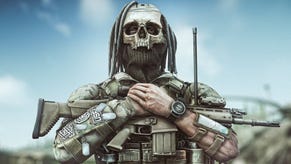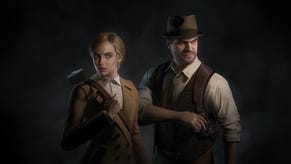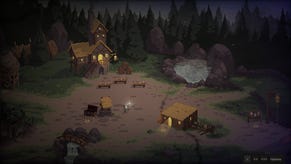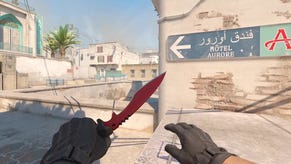S.T.A.L.K.E.R. I.N.T.E.R.V.I.E.W.
This interview with Anton Bolshakov of GSC Gameworld looks at this history of the company, the inspirations for S.T.A.L.K.E.R., the nature and mythology of Chernobyl, and the development of the “A-Life” living world system found in the game.
I originally conducted this interview earlier this year as research for a feature on S.T.A.L.K.E.R. commissioned by PC Gamer UK (click through to read it in full). Although I was pleased with the final, published draft, little of the material from the interview was used, and so I'm republishing it in full here.
RPS: Can you tell me a little about the background of GSC as a company?
Bolshakov: The company was originally formed in 1995 in Kiev, the capital of Ukraine. From 1997 we got down to computer games development and forming the team. At this point there started the development of a historical real-time strategy, Cossacks: European Wars, which was released worldwide in late 2000 and sold over four million copies to date.
This was an amazing success for our start-up company, especially taking into account that the main work on the project was made by a team of four. Cossacks served a start to a whole lineup of historic strategy games with over ten projects released in it. In 2005 the full-fledged sequel to Cossacks, named Cossacks II: Napoleonic Wars, was released. Additionally, we were behind the strategies Alexander (Oliver Stone’s movie tie-in) and Heroes of Annihilated Empires (self-published worldwide).
Our second, top-priority direction was 3D action games. In year 2000 there started the development of Oblivion Lost, subsequently named S.T.A.L.K.E.R.: Shadow of Chernobyl. We set our mark very high – the game ought to be the best in everything. We targeted creating the best engine, attaining realistic graphics, developing innovative concepts and delivering innovations to the genre.
It took us seven long years to develop and despite all the difficulties, the game came out and was praised by journalists and players. We expect a similar commercial success as with Cossacks.
At the moment sixty people work within the company. It is a very solid and professional team. Now, inspired by the success of S.T.A.L.K.E.R. we work on the development of the S.T.A.L.K.E.R. world and the next projects in the series.
RPS: How did the idea for the Stalker project originally come about?
Bolshakov: Splinters of Soviet Empire are plentiful in Ukraine – forgotten productions, catacombs, neglected military facilities and so on. Even our office is located at an ex-military factory with no more active production. When walking around such areas you can’t but think how the time froze at this place of man-made catastrophe. Logically, it struck us as a cool game setting to explore.
Next, the Soviet system was sealed, many facts were kept secret, so even the most harmless objectives or events generated unbelievable rumors and legends. For example, it is still not determined what exactly caused the 1986 explosion at the Chernobyl Power Plant. The official version claims the regular testing went out of control, however some say CNPP served a battery for secret laboratories, so what happened is an overload during one of the experiments being held. Another example is an existing gigantic antenna located within the Chernobyl exclusion zone. [The “brain scorcher” of the game – RPS]. On some of our photos taken during the trip to Chernobyl, the body of the antenna is seen on the horizon spanning several hundred meters across. As some unofficial sources claim, the waves emitted by the antenna were psycho-active. The antenna was directed onto Western Europe and preoccupied with a long-lasting military experiment on psychotropic influence onto human psyche. Similar examples can be found in batches. It was around this sort of experiments and theories that the S.T.A.L.K.E.R. story was evolving. We’ve got room for both conspiracy theory and the opposition of special services. Our game sort of expands onto what could have happened in reality. It’s a story about a post-apocalyptic world with its own tragedies, heroes and laws.
After that, [our inspiration] was the accident in Chernobyl itself. A murky and terrifying example for mankind of thoughtless use of high technologies.
Living among this all, we came up with the idea of the Zone and s.t.a.l.k.e.r.s. living within. Then we generated the idea of A-life which controls all the characters in the Zone and makes the world a living-and-breathing one. When all these components were imagined together, we realized it was going to be an amazing game concept.
RPS: How important was the book 'Roadside Picnic' and the film 'Stalker' to the development of your game?
Bolshakov: As important as an inspiration can be. We are old fans of Strugatsky brothers’ creations, however the game in no way repeats the book or the movie. We created our own game world, story, characters and so on, so considering S.T.A.L.K.E.R. an adaptation of the “Roadside Picnic” and “Stalker” movie would be wrong.
RPS: Can you explain a little bit about the decision to set the game within the Chernobyl zone?
Bolshakov: The accident in Chernobyl of 1986 is one of the black pages in the history of Ukraine. When it happened, the entire world was alarmed by the radioactive contamination danger. Unfortunately, many facts about the accident and its consequences were concealed by the USSR government. As time passes, people start forgetting about the accident and the related problems which Ukraine has to cope with, now virtually independently. So, for several reasons Chernobyl has been a very unique and an amazing game concept: global public awareness of the setting, mysteriousness of the place, radioactivity dangers, talks about mutations – all combines into a solid concept of a horror-filled atmospheric shooter. The motif behind S.T.A.L.K.E.R. was to create a game which would remind people of the Chernobyl accident and at the same time warn mankind against any possible fatal mistakes in the future.
RPS: Do you think that the existence of the Chernobyl has helped to create a more authentic game than you might otherwise have produced?
Bolshakov: I think Chernobyl was very important to create the kind of environment, architecture and other details S.T.A.L.K.E.R. is particularly known-for. Ruins of old Soviet industrial complexes, blocks of flats, military and civil facilities, vehicles and so on are still plentiful around ex-USSR. However, those traces of old empire can hardly be felt as keen and striking as in the Chernobyl zone. To me it’s living history, as life has been still there for over twenty years now, ending back in USSR times. It was only after visiting Chernobyl that we were able to render the atmosphere of true post-apocalyptic Soviet world which we intended to deliver.
RPS: How did the idea for the Stalker concept change over time? How did THQ influence its outcome?
Bolshakov: Until year 2002 the initial concept (back then the project was called simply Oblivion Lost) was oriented on fifteen linear levels, similarly to classic adventure shooters. An anomalous Half-Life, if you like. However in spring-summer 2002 the concept got drastically changed and Chernobyl was made the center of the game. We decided to implement a huge world of the 30-square-kilometer zone around the Chernobyl Power Plant, split it into locations and use a feature nobody ever used in shooters – life simulation. We had a very strong concept to go in line with our robust engine. It was a concept which, in our estimations, would remain relevant and innovative even after a decade.
Then in 2004 there was one more change to the concept when we rejected the fully “A-Life”-driven game without the story and obligatory tasks, where any [NPC] s.t.a.l.k.e.r. could complete the game ahead of the player. When we had assembled a playable prototype we realized that such a concept would barely be understandable to the players. It was either too much or too little of gameplay content, while everything was under the control of A-Life. It was frequent that the players didn’t understand what to do next. Such a concept required considerable improvement and a search for a form both understandable and involving to the players. In May 2005 such a solution was found – we placed the storyline within the A-Life world. It is this very concept that you can see in the game today.
We started working closely with THQ’s Producer Dean Sharpe in early 2006. I respect Dean’s professionalism: when he joined the project he understood that drastic changes to the game at this development stage may completely ruin all the deadlines. Therefore, we focused on finalising the current concept and the features which worked 100%. Some of the features were cut from the game or put aside for the next iterations. We concentrated on polishing up the gameplay, balance, difficulty levels…
RPS: So what were the biggest problems you faced during development?
Bolshakov: There were many tough elements to do, however hardly any of those compares to the AI system implemented in the game. Despite all the bottlenecks, however, the AI done is neat and dynamic. A-Life, as part of the general AI, proved one of the most challenging, of course. At some points we even thought the A-Life was just impossible to do. However, it’s there and now the A-Life can happily control a huge number of characters in the Zone, their traveling, life cycles. The A-life is responsible for creating background events, so as multitude of secondary tasks.
Also, combining the storyline contents with A-Life part wasn’t a trivial job. The thing is, all the story events must be played-through and experienced by the player, but A-Life is a totally dynamic system constantly in motion. We managed to find an elegant solution where the story tasks are put inside the A-Life world, however until the player has interacted with the former, no A-Life events could be happening in the area. Once the player has accomplished his quest, the A-life gradually fills up the spot previously inaccessible to the system. Hence, when you come back to the level previously completed, each time you will find a new A-Life-driven playthrough and new secondary missions.
RPS: And this A-Life/story hybrid is what you are most proud of?
Bolshakov: We are proud to have been able to implement the ideas of a huge living-and-breathing world where the player obtains a great deal of freedom; he is not limited by shooter-standard corridor limits; the player can act at his will and see how the outer world reacts to his doings. We are very glad we managed to implement the unusual mix of FPS and RPG, integrating the elements of stealth, horror, so as provide a unique playthrough to each of the players. This what makes S.T.A.L.K.E.R., undoubtedly, stand out from the rest. It should be noted, the ideas of A-Life, AI independent of the player bear great potential for the future development.
RPS: Will GSC be attempting another project of similar ambition in the future?
Bolshakov: The experience gained while developing S.T.A.L.K.E.R. is hard to underestimate. We have learned a lot, made a lot of trial and error – it was an excellent school training for the team. Now we are a solid and professional team. And we already have such an ambitious project in mind – it’s going to be S.T.A.L.K.E.R. 2!
We're aiming to discuss the possibilities of a sequel, GSC's independent status, and the forth-coming expandalone for S.T.A.L.K.E.R, Clear Sky, in the next couple of weeks.













